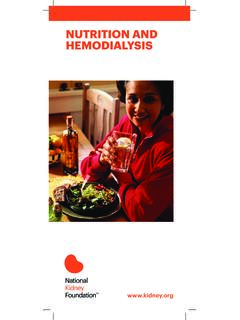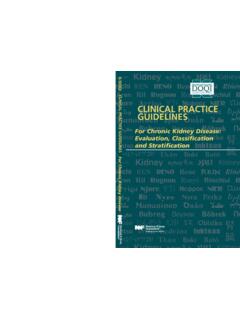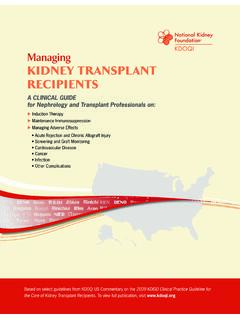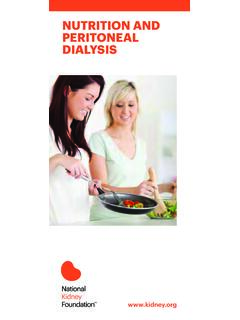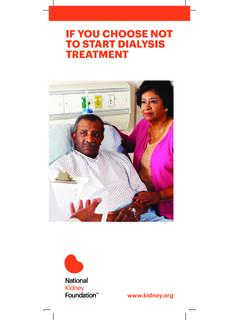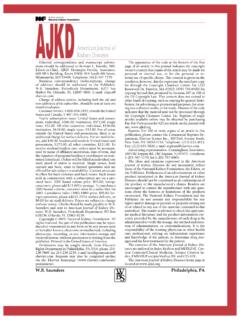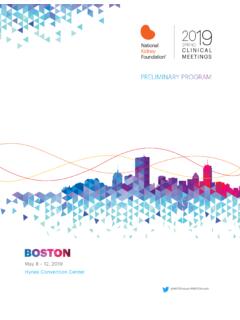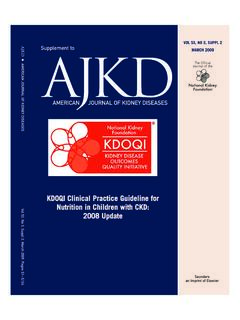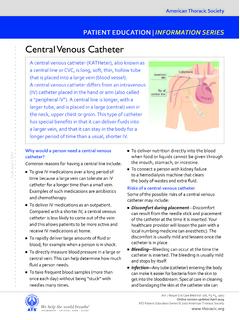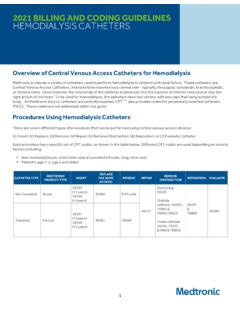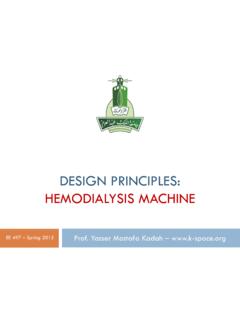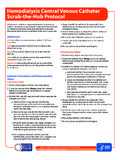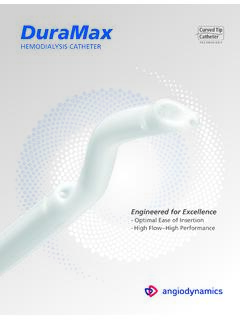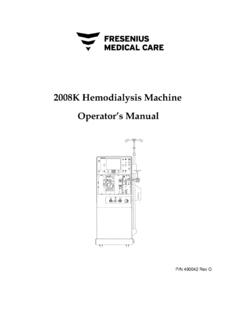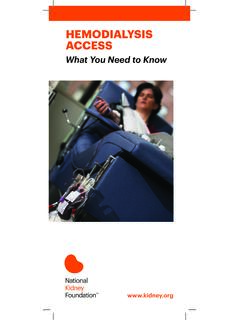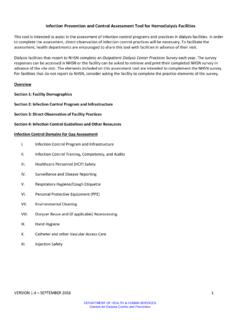Transcription of Renal Replacement Therapy: Options and Choices
1 Renal Replacement Therapy: Options and Choices Marc L. Weber, Nephrologist University of Minnesota Minneapolis, MN That disclosure I have no financial or other disclosures and will not discuss off label use of any medication. Learning Objectives Identity Renal Replacement therapy Options for patients with end stage Renal disease (ESRD). Self Assessment Questions 1. Renal Replacement therapy should be considered if the patient is experiencing: oA. Hyperkalemia oB. Metabolic acidosis oC. Fluid overload oD. All of the above 2. Types of hemodialysis access include: oA.
2 Fistula oB. Graft oC. catheter oD. All of the above Indications for Renal Replacement Therapy Hyperkalemia* Metabolic acidosis* Fluid overload (recurrent CHF admissions)* Uremic pericarditis (rub) Other non specific uremic symptoms: anorexia and nausea, impaired nutritional status, increased sleepiness, and decreased energy level, attentiveness, and cognitive tasking, .. *Refractory to medical management Treatment Options for Kidney Failure ESRD hemodialysis Kidney Transplant Peritoneal Dialysis Comfort Care ESRD, end-stage Renal disease Treatment Options for Kidney Failure ESRD hemodialysis Kidney Transplant Peritoneal Dialysis Comfort Care Dialysis Options Dialysis In-Center(dialysis clinic) Home In-Center hemodialysis -3 x week -Nocturnal Peritoneal Dialysis -Manual (CAPD) -Cycler (CCPD) Home hemodialysis -3-5 x/week -Day or nocturnal What is the most common modality to replace kidney function?
3 A. In-Center(clinic) hemodialysis B. Peritoneal Dialysis C. Transplantation D. Home hemodialysis Incident Patient Counts (USRDS) by 1st Modality USRDS ADR 2014 Trends in the number of incident cases of ESRD, in thousands, by modality, in the population, 1980-2012 Proper (fomerly early) Referal to nephrology: oWhen eGFR < 30 ml/ m2 Education about Renal Replacement therapy: oKidney Transplantion Refer to transplant center when eGFR < 20 ml/ m2 Even transplant before dialysis initiation (pre-emptive) Living kidney transplant (family, friends, facebook) Build time on list before dialysis initiation oHemodialysis (No catheters please including PICCs) oPeritoneal Dialysis (The only catheter you want) Proper Referral & Education PICC, peripherally inserted central catheter Advantages of Proper Referral Greater use of transplantation and home dialysis Fewer venous (hemo)
4 Catheters More peritoneal catheters Avoid emergent hemodialysis initiation oBack to the catheter issue oTakes away patient choice Better medication management More time to counsel patients oChallenging life transition KDIGO Transplant Guidelines Multidisciplinary Care in Progressive CKD Patient Education and counseling oWe all need to contribute Protocols for laboratory and clinic visits oDecrease variation-use best practices! oPharmacists/nurses/dietitians are probably best Ethical, psychological, and social care oDid you discuss the option of no RRT? oDoes the patient have a health care directive?
5 OSocial workers know the available resources Dietary/lifestyle modifications oDietitians are best at Vaccination program oWe all should heavily promote (even republicans) hemodialysis (HD) Principle of hemodialysis Vein Artery hemodialysis Filter (Dialyzer) Solute Mass Transfer During hemodialysis Solids ICF ECF IV HD Harmon W, Jabs K: hemodialysis (chap 77) in Pediatric Nephrology, 4th ed Barratt, Avner, Harmon (ed) Lippincott, 1999 A patient with advanced CKD has opted for home- hemodialysis . Which type of vascular access is associated with better outcomes in hemodialysis patients?
6 A. hemodialysis catheter B. Arteriovenous graft C. Arteriovenous fistula D. Temporary central venous catheter hemodialysis Access Provides access to bloodstream for dialysis One of the most challenging aspects of dialysis oStenosis oThrombosis Truly a lifeline oPatients run out of access sites! oNo PICCs, blood draws, BP on non-dominant arm oMore on this later hemodialysis Vascular Access Polytetrafluoroethylene hemodialysis Access AV Fistula oVein cross-cut, attached end-to-side to artery oHigh-pressure flow dilates and thickens vein oBest alternative.
7 Lowest infectious risk Longest lasting with least thromboses oDrawbacks Takes 2-4 months to mature Only about 50% ever mature oGoal for all hemodialysis patients hemodialysis Access AV Graft oTube made of biocompatible material (gortex) attached end-to-side to artery and vein oOften required in patients with vascular disease, occluded distal veins oAdvantages Ready to use when swelling resolves (~2 weeks) Able to use in most patients oDisadvantages High stenosis/thrombosis rate Moderate infectious risk hemodialysis Access catheter (Internal jugular [IJ] most common)
8 OTunnelled under skin to reduce communication from skin flora with blood oAdvantages Ready for use immediately oDisadvantages High infectious risk High thrombosis risk A/W increased mortality Can be a sign of poor pre-dialysis care or extensive vascular disease SAVE the Non-Dominant ARM for Vascular Access When GFR < 30 mL/min oNo BP measurement oNo IV oNo Blood Draws oNo PICCs Place vascular access within a year of hemodialysis anticipation .. Not on Non-Dominant Arm, please! Peritoneal Dialysis (PD) Principles of PD Treatment PD Treatment Kidney Transplantation Stay Tuned!
9 Thanks, but no not to start or to stop dialysis To cure sometimes, to relieve often, and to comfort always-this is our work. -Anonymous For people >80yo, which disease has the highest mortality? A. ESKD on dialysis B. Cancer C. CHF D. AMI Adjusted all-cause mortality in 2012 Age 80+ USRDS 2014 ADR Where do dialysis patients die? USRDS 2014 ADR Where do dialysis patients want to die? A. Hospital B. ICU C. Dialysis unit D. Home In the last month of 80% of dialysis patients hospitalized o50% are in the ICU o30% received aggressive/invasive procedures o20% referred to hospice < half the national average 75% of dialysis patients do not want to die in the hospital Wong.
10 Arch Intern Med. 2012 Take Home Points Planning ahead (proper referral) is key to improve outcomes for dialysis patients Education allows patients to get the care that s right for them hemodialysis catheters associated with mortality Hospice referral is underutilized Multidisciplinary team approach to care is required for improved outcomes Self Assessment Questions 1. Renal Replacement therapy should be considered if the patient is experiencing: oA. Hyperkalemia oB. Metabolic acidosis oC. Fluid overload oD. *All of the above* Rationale: Dialysis can help regulate potassium, acid/base balance and fluid.
